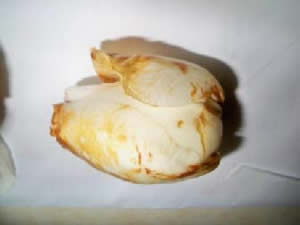
Recently I’ve been receiving calls and pictures regarding camellia flowers being discolored after opening or some being discolored and only partially opening. On white camellia flowers the flower petals take on a tan to brown color and many fall to the ground. After discussions with Dr. Raj Singh, LSU AgCenter Plant Pathologist , and Director of the Plant Pathology Lab at LSU, we concluded that the majority of the problems were caused by cold injury. However another problem that mimics cold injury is Camellia Flower Blight which is caused by Sclerotinia camelliae which becomes active during cool moist conditions.These conditions are what Dr. Singh refers to as favorable conditions for camellia flower blight. To those of you who had the fortune of sitting through Dr. Singh’s plant pathology class as you received classroom instructions to become a certified Master Gardener, you should have recalled that he said in order for infection to take place there are three things that need to be present: favorable conditions , a host, and a pathogen. When camellias are blooming in cool temperatures with abundant moisture, camellia flower blight is highly probable. Camellias growing in shade where moisture is more abundant are more susceptible. The fact that camellia flower blight mimics cold injury may be confusing to home gardeners because of the similar appearance, but remember, if the petals have a slippery, slimy texture then it’s camellia flower blight. If the discolored petals have a dry leathering feel then in all likelihood it is cold injury. If it is camellia flower blight all infected flowers that fall to the ground should be picked up and discarded. Some gardeners even picked the infected flowers off the plant and discarded them. If this is not done, the pathogen will over winter in the old infected flowers and be there to infect the next crop of camellia flowers.


Horticulturist/Master Gardener Program Coordinator
LSU AgCenterhere to edit.



 RSS Feed
RSS Feed